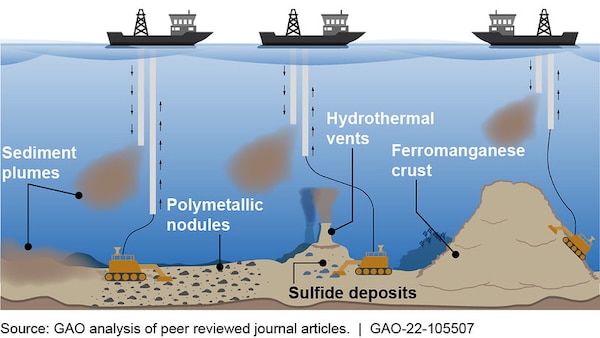This post was originally published on Eco Watch
Quick Key Facts
- The ocean covers more than 70 percent of the surface of the planet.
- The deep sea makes up 90 percent of the total marine environment and is the largest biome on Earth.
- More than 5,000 marine species live in the Pacific Ocean’s Clarion-Clipperton Zone, a focus area of deep-sea mining.
- Several countries — including Canada, France and New Zealand — have called for a moratorium on deep-sea mining.
- Deep-sea mining is not necessary to obtain the critical minerals needed for the renewable energy transition.
- Demand for critical minerals can be reduced by 58 percent by 2050 through the use of new technologies, circular economy strategies and increased recycling.
- 90% of electronic waste is dumped or illegally traded.
What Is ‘Deep-Sea Mining’?
Deep-sea mining is the process of retrieving mineral deposits from the ocean floor using destructive methods such as dredging, drilling and hydraulic pumps. These methods disrupt and harm marine life and their ecosystems.
The seabed is a largely unexplored world of unidentified species and mystery. The Clarion-Clipperton Zone — a 1.7 million square mile area of the Pacific Ocean — is a focal point of deep-sea mining for its polymetallic nodules rich in minerals such as copper, nickel, manganese, cobalt, rare earth elements and other precious metals used in the making of zero-carbon technology components. This abundant expanse is the subject of 17 exploration contracts with a total area of roughly 621,371 square miles — approximately the size of Ethiopia. But it is also home to more than 5,000 recently discovered marine species.

The sought-after nodules embedded in the ocean floor are about the size of a potato and take millions of years to form, along with mineral-rich crusts and sulfides surrounding hydrothermal vents. Due to recent technological advancements, mining these ecologically sensitive areas is achievable by razing the surface of the seabed, sweeping away layers of biodiverse sediment and pumping displaced and often destroyed organic materials back into the water.

Brief History of Deep-Sea Mining
Some small-scale exploratory mining has already taken place to test deep-sea mining equipment, but no commercial mining of the seabed has yet occurred. However, some mining companies and national governments have plans to start doing so as soon as they can — possibly in the next few years. Whether that happens or not will mostly depend on how the International Seabed Authority (ISA) chooses to regulate deep-sea mining.
In 2021, Nauru — a tiny Pacific Island nation in Micronesia — gave the ISA notice that it planned to start mining in international waters. This triggered the “two-year rule,” a controversial provision of the United Nations Convention on the Law of the Sea (UNCLOS). The rule mandates that the ISA must “consider” and “provisionally approve” deep-sea mining applications, whether or not there has been a finalized set of regulations.
The two years was completed for the Nauru application in July of 2023, but the ISA meeting that followed concluded without a final rule being agreed upon. The 168-member ISA Assembly has been working on establishing the rules for deep-sea mining. ISA’s Council — made up of 36 Assembly-elected members — has a goal of adopting finalized regulations by 2025.
As of July of last year, several nations — including Canada, Chile, Costa Rica, France, Palau and New Zealand — had called for a moratorium on deep-sea mining. According to the Pew Charitable Trusts, before regulations are adopted, the ISA must address how the impacts of mining will be monitored and addressed, what level of harm is allowed and how compliance with the regulations will be enforced.
Currently, contractors like corporations or individuals are only permitted to extract seabed minerals if they are sponsored by a UNCLOS state party and have obtained an exploitation contract from the ISA.
Contractors are required to use best environmental practices and a precautionary approach in order to control or prevent hazards like pollution of the marine environment. In addition, they must develop programs for evaluating and monitoring impacts in conjunction with the ISA. Consultation between stakeholders is also mandated at crucial junctures of the exploration stage — a period that can take years.
While they wait for an international waters code of conduct, countries can still proceed with mining projects inside domestically controlled waters, or “exclusive economic zones” (EEZs).
In January of 2024, Norway started the process of opening its waters to deep-sea mining exploration, which would likely begin in the 2030s.
Most mineral deposits that are sought after by mining operations are located outside EEZs on the vast abyssal plains of international waters, such as the Clarion-Clipperton Zone.
Arguments for Deep-Sea Mining
Those in favor of deep-sea mining say it will help meet the growing need for critical minerals used in the global decarbonization process. As we rely more on solar and wind energy, electric vehicles and other green technologies, the demand for some of these minerals could increase by four to six times. However, studies have shown that there are plenty of land-based sources for critical minerals.
Some proponents of deep-sea mining view it as a way to avoid some of the environmental hazards of mining on land, like pollution of freshwater by mining runoff and deforestation. But the destruction of marine life and ecosystems wrought by deep-sea mining means it would not be a better alternative for biodiversity or the planet.

Threats Posed by Deep-Sea Mining
Harms Marine Life and Ecosystems

The largest biome on the planet — 90 percent of the total marine environment — the deep sea is home to vast biodiversity that is being threatened by deep-sea mining. It is highly likely that the heavy equipment used to mine the seabed would kill less mobile deep-sea creatures.
Many deep-sea species make their homes in the polymetallic nodules that are the harvest of deep-sea mining operations. The nodules develop over millions of years, so the recovery of the ecosystems they support would be extremely slow if possible at all. The removal and destruction of these important habitats would almost surely result in the extinction of some species.
Releases Stored Carbon
Not only is the ocean floor home to an unknown wealth of species, it plays an essential role in the regulation of our planetary systems by absorbing and storing enormous amounts of the carbon dioxide humans emit through the burning of fossil fuels, deforestation, industrial enterprises, agriculture and other activities.
Approximately 25 percent of the carbon dioxide emitted by humans is absorbed and sequestered by the ocean’s deep-sea microscopic organisms. The ocean is Earth’s biggest carbon sink, storing approximately 38,000 gigatons of the greenhouse gas.
Mining the seafloor can cause the release of carbon sequestered in sediments and reduce deep-sea biodiversity, impacting the ocean’s carbon cycle and exacerbating the climate crisis.
For each kilometer of the seabed that is mined annually, 190.2 tons of carbon could be released through sediment plumes. These plumes can block sunlight, reducing the photosynthetic abilities of marine organisms who help mitigate temperature increases worldwide by absorbing carbon for energy.

Releases Toxic Sediment Plumes
There are many detrimental impacts to marine life and ecosystems by the release of sediment plumes during the deep-sea mining process. Among the most direct and devastating is that the plumes can suffocate and smother organisms who make their home on the seafloor. Some of these creatures are not as mobile and may be killed by the mining equipment itself.
Clouds of sediment have the potential to choke midwater marine ecosystems. The plumes can interfere with the reproduction and feeding of species through the introduction of heavy metals like cadmium and copper into the natural food chain. These metals can also be released in toxic concentrations when seafloor sediments are disturbed, polluting the water column. The metals can have deadly effects on filter feeders and organisms who are unable to move freely, like sessile suspension fauna.

The discharge of mining wastewater can also create underwater dust storms that pollute and confuse marine organisms, preventing them from navigating through the water, feeding and reproducing.
Light Pollution
Marine organisms are used to an environment that is quiet, dark and peaceful. In addition to the direct harm caused by the process of mining the ocean floor, longer ecosystem and species disruptions can result from mining activities, such as light pollution interfering with reproduction and feeding.
Noise Pollution
Sound pollution from deep-sea mining can impact large whales, narwhals, dolphins and other marine mammals who rely on echolocation — or biological sonar — to hunt, navigate and locate one another. These species are already threatened by human activities like fishing and boating, as well as human-caused climate change.
Leaves Behind Waste Materials That Poison Marine Life and Impact Fisheries and Food Security
Mining wastewater is warm and filled with chemicals, which can kill marine animals by overheating and suffocating them. The chemicals also pollute the ocean floor and water column, making the seawater toxic, as well as altering its pH and oxygen content, all of which are harmful to marine life.
Waste discharge can diffuse across large distances, posing a threat to fish and invertebrates who live in the open ocean. These marine species are essential to the fisheries and economies of small island developing nations like Vanuatu, the Marshall Islands and Kiribati.

Economic and Social Risks of Deep-Sea Mining
Deep-sea mining is conducted offshore in the depths of the ocean, but the industry would still need to build facilities onshore to process and ship materials. This would require the acquisition and development of land, which leads to habitat loss and impacts on coastal communities who rely on marine resources for their food and livelihoods.
Minerals extracted from the high seas have been designated by the UN as “the common heritage of [hu]mankind” for the benefit of all nations. However, the current ISA regulatory regime seems to support the flow of profits to mining company shareholders and developed nations, instead of to developing countries.
Why Deep-Sea Mining Is Not Necessary for Renewable Energy
Deep-sea mining is not necessary to obtain the critical minerals needed for zero-carbon technologies. In order to supply the rare earth elements needed to meet the demands of the growing renewable energy sector, mining and processing of land-based mineral reserves must be increased responsibly to minimize negative environmental and social impacts.
In the coming 15 to 20 years, recycling of minerals will hopefully become a feasible alternative to mining. According to World Bank estimates, the significant increase of end-of-life battery recycling rates by mid-century could reduce the necessity of newly mined minerals by roughly 25 percent for nickel, lithium and copper, and approximately 15 percent for cobalt. Unfortunately, there will not be an adequate supply of these minerals circulating for recycling to be a workable approach by 2030.
Improved recycling methods in established channels — electrical and electronics, for instance — could lessen some of the shorter-term pressure on supply while preparing a secondary supply chain to tackle future end-of-life carbon-neutral energy products.
Research is also being done on obtaining critical minerals from hard rock mine tailings and coal waste, rather than mining undisturbed land.
The evolution of battery technologies may also make mineral deposits found in the deep seabed obsolete for renewable products. An example is the shift from those that use nickel manganese oxides toward lithium iron phosphate batteries. While the nodules that are the focus of deep-sea mining operations are rich in cobalt, nickel, copper, manganese and rare earth elements, they do not contain an abundance of lithium and iron.
Sodium-ion batteries could also change the EV battery market, replacing cobalt and lithium with alternatives that are more abundant and less expensive.
What We Can Do to Help Stop Deep-Sea Mining
Apply the ‘Three Rs’ to Electronic Products
The more we do to ensure mining for minerals is avoided, the better it will be for the environment. One of the best ways to do this is to apply the “three Rs” — reducing, reusing and recycling — to batteries, cell phones, computers and even renewable energy products like solar panels.
Choose Sustainable Alternatives
A shift away from traditional lithium-ion and nickel manganese cobalt oxide batteries to those made with lithium iron phosphate, which do not need cobalt or nickel — raw materials sought through deep-sea mining — could help lessen the pressure to find as many critical minerals.
Other alternatives being developed include sodium-ion batteries — a more abundant and less expensive choice — which could replace cobalt and lithium.
Do Away With Electronic Waste
The vast majority of electronic waste — 90 percent — is dumped or illegally traded. More copper and cobalt is discarded each year in e-waste than could be supplied by deep-sea mining in the central Pacific Ocean for a decade.
To cut down on e-waste, we can encourage governments to pass “right to repair” legislation, as they have in Portland, Oregon. These laws ban disposable electronics, make fixing products easier and develop standards for helping consumers identify longer-lasting products.
Reduce Overconsumption
One of the best ways to reduce electronic waste is to not buy electronics you don’t really need in the first place. When you do decide to spring for a new electronic device, donate or sell your old one online or bring it to a local electronic collection center.
Another way to reduce overconsumption and e-waste is to buy quality products that will last and won’t need to be replaced quickly. You can also purchase gadgets with repair services and extended warranties. It’s always a good idea to check a product’s lifespan before purchasing it.
Avoid electronics that are trendy and will go out of style. Some products will try and tempt you with the latest upgrade when it really isn’t that different from earlier models. Avoiding the urge to stay “up to date” can mean creating a lot less e-waste. You can also support companies that use sustainable manufacturing practices.
Build a Circular Economy
A 2022 report by SINTEF found that we can reduce critical mineral demand by 58 percent by 2050 by using circular economic strategies, new technologies and increased recycling.
One option is to use the minerals we already have access to through urban mining. Another is to develop improved designs and technologies so that we can recover minerals from products that are no longer being used.
Takeaway
There are many environmental reasons not to pursue deep-sea mining — its impacts on marine animals and the environment, as well as its ecological implications.
As we stand on the cusp of a full transition away from fossil fuels to a world powered by green energy and a circular economy, it is essential that we focus our energies on sourcing minerals in a way that doesn’t decimate habitats and ecosystems. To do this, we must prioritize increased critical minerals recycling, ethical land-based mining practices and improved product designs so that they can be used and reused longer without needing to be replaced, thereby reducing demand for these elements.

The post Deep-Sea Mining 101: Everything You Need to Know appeared first on EcoWatch.





0 Comments